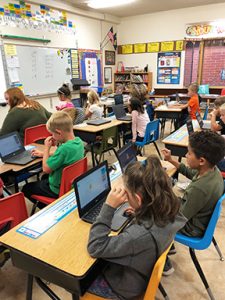 The Stevensville School District has been quietly developing technology infrastructure throughout the District for the past three years. In that time, the District has moved from radio relay internet access to fiber optic connectivity and has increased the bandwidth available for instruction from 100 MB to 1 GB.
The Stevensville School District has been quietly developing technology infrastructure throughout the District for the past three years. In that time, the District has moved from radio relay internet access to fiber optic connectivity and has increased the bandwidth available for instruction from 100 MB to 1 GB.
A significant amount of this work was made possible by the technology levy passage in 2017. Since that time, the internal network has been upgraded with new hubs and switches and access points have been added throughout the buildings. Technology Director, Roger Cassidy, has worked with Pine Cove computer consultants to fix a number of network problems to ensure that the technology backbone is ready for higher levels of access and usage throughout the schools.
With the network access now available, the Stevensville School District is moving rapidly toward a one to one computer environment. In this environment, students have ready access to Chromebooks and computing devices throughout the day. They no longer will need to wait for the availability of computer labs and devices as these are now available in the classroom.
Teachers have been training for this implementation for the past two years and have a variety of instructional opportunities to engage students through Google Tools for Education as well as other programs. Students can access their work at any time on or off campus and can engage in group work with their peers for projects and assignments.
Scott Seibert, elementary computer science teacher and dean of students, sees the change in the learning environment as an essential skill for students in the age of technology. According to Seibert, “students have access to an infinite amount of tools when using the proper technology. With guidance, they can utilize these tools for learning.”
In the coming months, the District will continue to execute a plan to provide more computers to students throughout the district which will enable them to engage in unique science, technology, engineering, and mathematics (STEM) learning opportunities as well as expanded curricula through the Montana Digital Academy.
Seibert said that the educational environment is changing rapidly. “Students are expected to be able to compete globally upon graduation and have computer science skills to be competent in the workplace.”